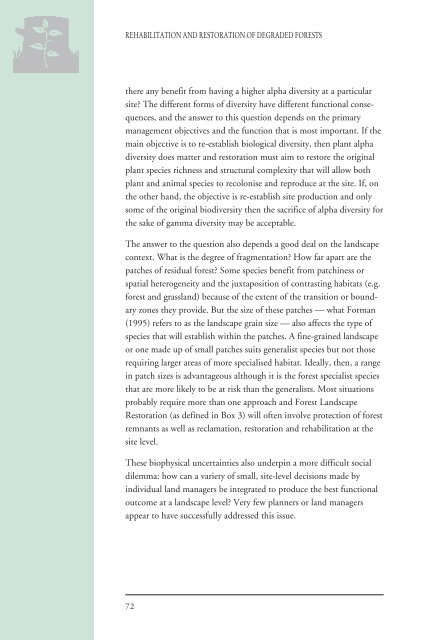Rehabilitation and Restoration Of Degraded Forests (PDF) - IUCN
Rehabilitation and Restoration Of Degraded Forests (PDF) - IUCN
Rehabilitation and Restoration Of Degraded Forests (PDF) - IUCN
Create successful ePaper yourself
Turn your PDF publications into a flip-book with our unique Google optimized e-Paper software.
REHABILITATION AND RESTORATION OF DEGRADED FORESTS<br />
there any benefit from having a higher alpha diversity at a particular<br />
site? The different forms of diversity have different functional consequences,<br />
<strong>and</strong> the answer to this question depends on the primary<br />
management objectives <strong>and</strong> the function that is most important. If the<br />
main objective is to re-establish biological diversity, then plant alpha<br />
diversity does matter <strong>and</strong> restoration must aim to restore the original<br />
plant species richness <strong>and</strong> structural complexity that will allow both<br />
plant <strong>and</strong> animal species to recolonise <strong>and</strong> reproduce at the site. If, on<br />
the other h<strong>and</strong>, the objective is re-establish site production <strong>and</strong> only<br />
some of the original biodiversity then the sacrifice of alpha diversity for<br />
the sake of gamma diversity may be acceptable.<br />
The answer to the question also depends a good deal on the l<strong>and</strong>scape<br />
context. What is the degree of fragmentation? How far apart are the<br />
patches of residual forest? Some species benefit from patchiness or<br />
spatial heterogeneity <strong>and</strong> the juxtaposition of contrasting habitats (e.g.<br />
forest <strong>and</strong> grassl<strong>and</strong>) because of the extent of the transition or boundary<br />
zones they provide. But the size of these patches — what Forman<br />
(1995) refers to as the l<strong>and</strong>scape grain size — also affects the type of<br />
species that will establish within the patches. A fine-grained l<strong>and</strong>scape<br />
or one made up of small patches suits generalist species but not those<br />
requiring larger areas of more specialised habitat. Ideally, then, a range<br />
in patch sizes is advantageous although it is the forest specialist species<br />
that are more likely to be at risk than the generalists. Most situations<br />
probably require more than one approach <strong>and</strong> Forest L<strong>and</strong>scape<br />
<strong>Restoration</strong> (as defined in Box 3) will often involve protection of forest<br />
remnants as well as reclamation, restoration <strong>and</strong> rehabilitation at the<br />
site level.<br />
These biophysical uncertainties also underpin a more difficult social<br />
dilemma: how can a variety of small, site-level decisions made by<br />
individual l<strong>and</strong> managers be integrated to produce the best functional<br />
outcome at a l<strong>and</strong>scape level? Very few planners or l<strong>and</strong> managers<br />
appear to have successfully addressed this issue.<br />
72

















